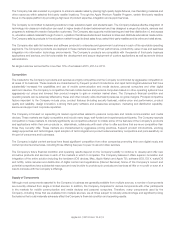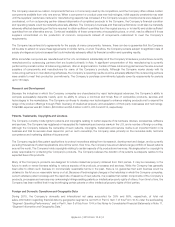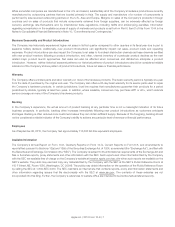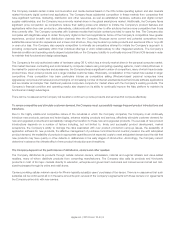Apple 2015 Annual Report Download - page 16
Download and view the complete annual report
Please find page 16 of the 2015 Apple annual report below. You can navigate through the pages in the report by either clicking on the pages listed below, or by using the keyword search tool below to find specific information within the annual report.The Company’s retail stores have required and will continue to require a substantial investment and commitment of resources and
are subject to numerous risks and uncertainties.
The Company’s retail stores have required substantial investment in equipment and leasehold improvements, information systems,
inventory and personnel. The Company also has entered into substantial operating lease commitments for retail space. Certain stores
have been designed and built to serve as high-profile venues to promote brand awareness and serve as vehicles for corporate sales and
marketing activities. Because of their unique design elements, locations and size, these stores require substantially more investment than
the Company’s more typical retail stores. Due to the high cost structure associated with the Company’s retail stores, a decline in sales or
the closure or poor performance of individual or multiple stores could result in significant lease termination costs, write-offs of equipment
and leasehold improvements and severance costs.
Many factors unique to retail operations, some of which are beyond the Company’s control, pose risks and uncertainties. These risks and
uncertainties include, but are not limited to, macro-economic factors that could have an adverse effect on general retail activity, as well as
the Company’s inability to manage costs associated with store construction and operation, the Company’s failure to manage relationships
with its existing retail partners, more challenging environments in managing retail operations outside the U.S., costs associated with
unanticipated fluctuations in the value of retail inventory, and the Company’s inability to obtain and renew leases in quality retail locations
at a reasonable cost.
Investment in new business strategies and acquisitions could disrupt the Company’s ongoing business and present risks not
originally contemplated.
The Company has invested, and in the future may invest, in new business strategies or acquisitions. Such endeavors may involve
significant risks and uncertainties, including distraction of management from current operations, greater than expected liabilities and
expenses, inadequate return of capital and unidentified issues not discovered in the Company’s due diligence. These new ventures are
inherently risky and may not be successful.
The Company’s business and reputation may be impacted by information technology system failures or network disruptions.
The Company may be subject to information technology system failures and network disruptions. These may be caused by natural
disasters, accidents, power disruptions, telecommunications failures, acts of terrorism or war, computer viruses, physical or electronic
break-ins, or other events or disruptions. System redundancy may be ineffective or inadequate, and the Company’s disaster recovery
planning may not be sufficient for all eventualities. Such failures or disruptions could, among other things, prevent access to the
Company’s online stores and services, preclude retail store transactions, compromise Company or customer data, and result in delayed
or cancelled orders. System failures and disruptions could also impede the manufacturing and shipping of products, delivery of online
services, transactions processing and financial reporting.
There may be breaches of the Company’s information technology systems that materially damage business partner and customer
relationships, curtail or otherwise adversely impact access to online stores and services, or subject the Company to significant
reputational, financial, legal and operational consequences.
The Company’s business requires it to use and store customer, employee and business partner personally identifiable information (“PII”).
This may include, among other information, names, addresses, phone numbers, email addresses, contact preferences, tax identification
numbers and payment account information. Although malicious attacks to gain access to PII affect many companies across various
industries, the Company is at a relatively greater risk of being targeted because of its high profile and the amount of PII it manages.
The Company requires user names and passwords in order to access its information technology systems. The Company also uses
encryption and authentication technologies designed to secure the transmission and storage of data and prevent access to Company
data or accounts. As with all companies, these security measures are subject to third-party security breaches, employee error,
malfeasance, faulty password management, or other irregularities. For example, third parties may attempt to fraudulently induce
employees or customers into disclosing user names, passwords or other sensitive information, which may in turn be used to access the
Company’s information technology systems. To help protect customers and the Company, the Company monitors accounts and systems
for unusual activity and may freeze accounts under suspicious circumstances, which may result in the delay or loss of customer orders.
Apple Inc. | 2015 Form 10-K | 14
























